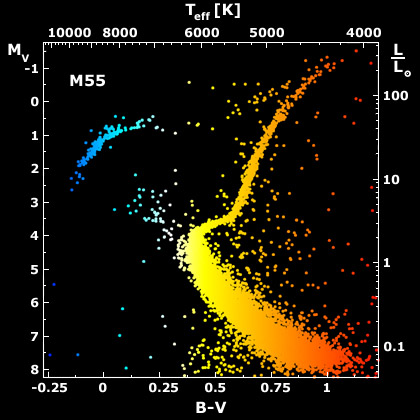
|
Tying Things Together:
Hertzsprung-Russell Diagram, Mass-Luminosity Relation, ....
|
I. Limited Russell-Vogt Theorem
This statement is so powerful that it has been given the name the
Russell-Vogt theorem
(although it is not a theorem in
the mathematical sense).
Why the Russell-Vogt theorem
in the above form is
true will be explained when we talk about stellar structure.
II. Hertzsprung-Russell Diagram (H-R Diagram)
We know the masses, radii, luminosities, and
surface temperatures
of many stars.
Question:
How do we make sense of the plethora of available data?
The first step
is to graph the data.
The reason we go
through this exercise is because plots can indicate
whether properties of different stars are correlated, that is, if there
is seems to be a physical
relationship (connection) between the different properties.
H-R Diagram
In the early 1900's, Ejnar Herstzprung and Henry Norris Russell
independently made the discovery that the luminosity of a star is related to
its surface temperature. The resulting plot
is amazing.
A schematic Hertzsprung-Russell diagram is shown to the right.
A Hertzsprung-Russell diagram for the old cluster M55
(Mochejska & Kaluzny, see APOD, 2001 Feb 23) is the top panel
on this page. The Hertzsprung-Russell (HR) diagram
was one of the most
important astronomical discoveries of the twentieth century.
Hertzsprung and Russell used the spectral class
(which is related to the temperature, and color of the star [which is related
to B-V]) in their plots. They
ordered the stars as O, B, A, F, G, K, and M. Since
O stars are the hottest stars, this means that
the temperature axis in the HR diagram
is odd in that the temperature decreases as one
moves to the right. The veritcal axis is the luminosity of the star, it
increases upward. The axis is logarithmic (it mimics the human eye).
|
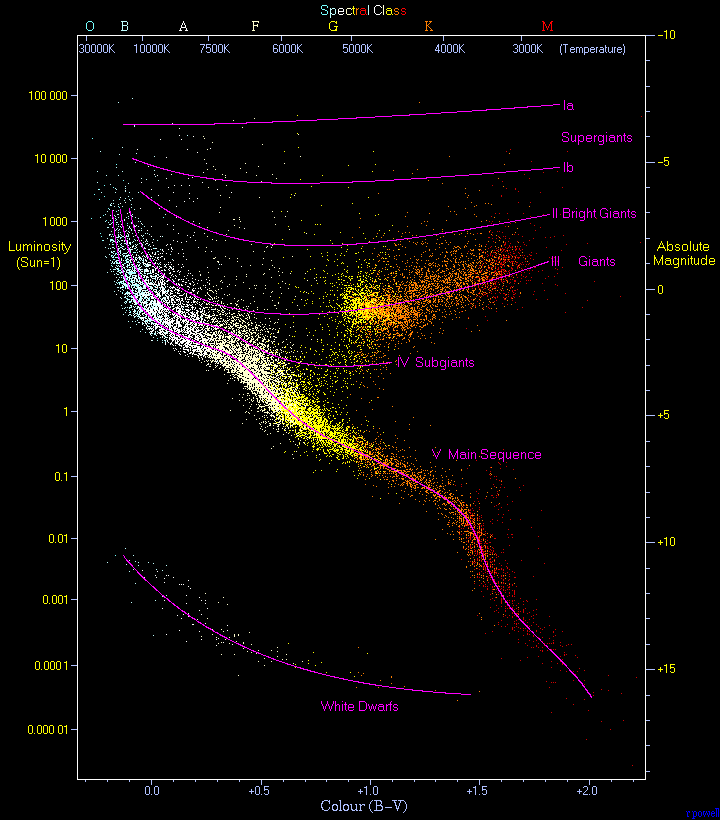
|
Stars are confined to
specific regions in the HR diagram.
This tells you that
there is some physical relationship between the luminosity and
temperature of a star. To make this point clear, let's look
at people. People have many defining characteristics, not all of
which are related. Let's plot some
properties of people and see what they look like. Consider,
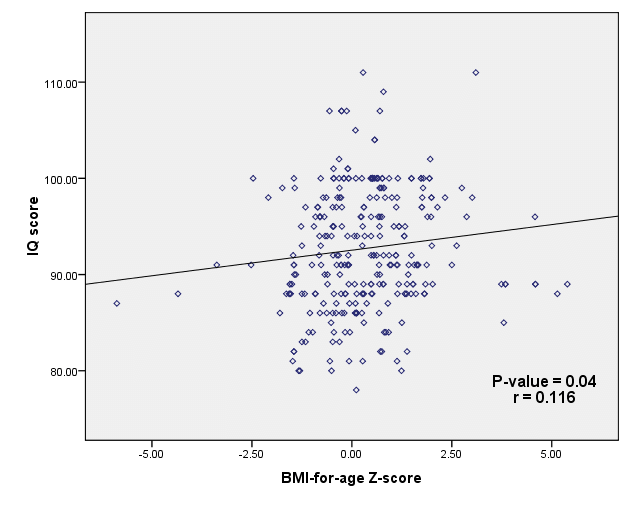 3
3
|
- The plot of IQ versus BMI is essentially a scatter diagram ===>
there isn't a physical relationship between IQ and BMI.
- The plot of weight versus height for a sample of people shows a
correlation
===> that there is something in the
structure of people which makes weight and height correlated.
This simple exercise taught us something about people. We
did not learn in detail how people are put together; we
learned that the
height and weight of people are somehow related. It is
up to theorists to explain the how and why of the physical
connection between the height and weight of the people
population.
Similarly, the HR diagram is not
telling us about how stars are put together. It is,
again, up to the theorists to tell us what is going on.
However, for now, let's ignore the role of the theorist and
just examine the HR diagram to see
what we can deduce about stars.
III. Inferences Based on the Hertzsprung-Russell Diagram

|

|
Luminosity Classes
I -- Super-Giants
II -- Bright Giants
III -- Normal Giants
IV -- Sub-Giants
V -- Main Sequence Stars
|
Question: What can we deduce from the HR diagram?
-
Let's address the names of the different groupings of
stars, i.e., Main Sequence, Giants, Super-Giants,
and White
Dwarfs.
These groups are referred to as Luminosity
Classes. Without having
actually measured the radii of all of these stars,
Question: How did we know that the stars in the upper right hand corner
of the diagram were big, while the stars in the lower left hand corner were
small?
(from Stefan-Blotzmann Law)
- Given a random sample of stars,
we find that roughly 85-90 % of the stars fall
along the Main Sequence and that
the bulk of the other stars are
White Dwarfs with < 1 % Supergiant
and Giant stars
.
Question:
What does the relative numbers of stars in these groupings tell us about how
long stars spend in the different Luminosity Classes, the
Main Sequence stars, Supergiant and Giant stars, white dwarf stars, and
so on?
- The percentages tell us the fractions of the lifetimes stars spend in
each of the Luminosity Classes
- We also find out that stars do not evolve significantly
while on the Main Sequence (stars do evolve as shown by the Sun, but not
significantly). That is, O stars are found to be massive with the masses
up to 50-100 times the mass of the Sun. The masses of the stars
fall as one moves along the Main Sequence. The lowest mass stars
are the M stars whose lowest masses as 10 % that of the Sun.
See the Table below.
Main Sequence Stars
Roughly, along the
Main Sequence stars have properties:
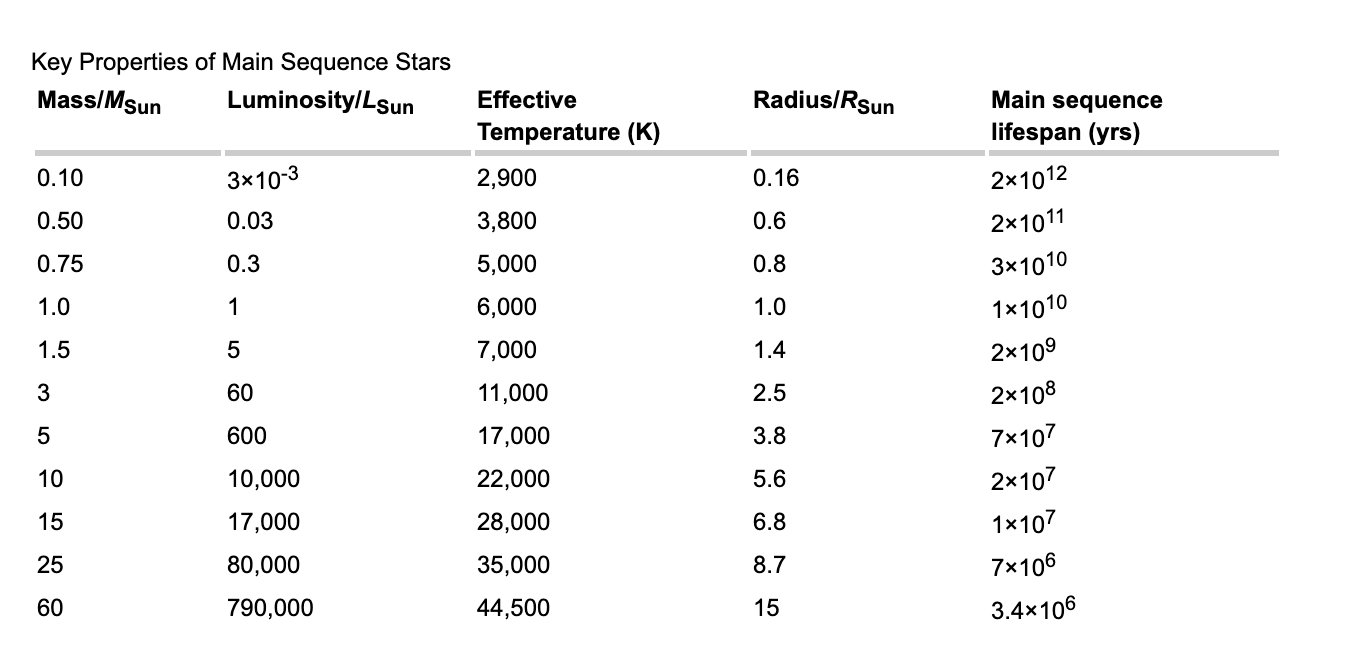
In the following boxes, we show simple relationships between the stellar
properties, the luminosity, radius, effective temperature, and the mass
of the star. |
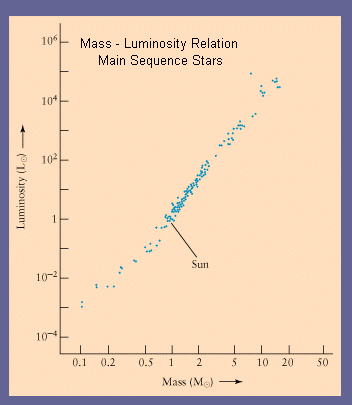 |
Mass-Luminosity Relation for Main Sequence Stars
When we consider Main Sequence
stars, is there any hint about
whether an individual star evolves along the
Main Sequence or
whether a star once on the Main Sequence
does not change its
position? We believe that stars do not move
along the Main Sequence. That is, Main Sequence
stars with particular
L have the same properties. This can be seen from the
Mass-Luminosity relationship for Main
Sequence stars where stars with a given mass M,
have a well-defined brightness, L.
The result shows that the upper end of the
Main Sequence (the most luminous stars)
is occupied by massives stars and the lower
end of the Main Sequence (the faintest
stars) is occupied by the least massive stars.
For stars more massive than around 0.7 solar masses, L ∝ M4
and for less massive strs, L ∝ M3. Because we know that
Main Sequence are characterized as stars that get their energy from fusion
reactions that convert hydrogen into helium in their cores, we may infer
how long Main Sequence stars live from
Lifetime = (Amount of Available Fuel)/(Rate Fuel is Burned)
= (M*c2/L)
Using the M-L relationhips, we see that
- Lifetime ∼ 10 (M*/MSun)-3
billion years for massive stars, and
- Lifetime ∼ 200 (M*/0.5 MSun)-2
billion years
for low mass stars.
Interestingly, stars whose masses are
a little less than that of the Sun have such long lifetimes that they
have not yet had time to run through their
Main Sequence lifetimes since the
start of the Universe 13.8 billion years ago!
|
|
|

|
Mass-Radius Relation for Main Sequence Stars
The size (radius) of Main Sequence stars increases with increasing stellar
mass as does the luminosity. The figure shown to the indicates roughly how the
size increases with mass. We see an interesting result for Main Sequence stars
which is that stars become less compact (less dense) with increasing stellar
mass. That is, as you go to the low temperature-low luminosity end of the Main
Sequence, the density of the stars actually increases.
The increase of the
stellar density (how compact are the stars) with decreasing stellar mass tells
us a lot (as we will show when discuss star formation). In particular,
this tells us us why there is
a lower limit on the mass of Main Sequence
stars.
|
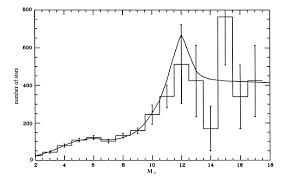
| Luminosity Function
In terms of mass, stsrs are not distriubted evenly along
the Main Sequence.
distributed smoothly. There are many more low luminosity stars than
there are high luminosity stars. A plot of this
distribution is known to as the
Luminosity Function.
The plot for the left area around the Sun, the Solar Neighborhood, but
it is representative of stars in
our Galaxy. Note that for stars the luminosity of our
Sun (in Absolute Magnitudes,
MV
~ 5). Based on this figure there are
around 4 stars every 103cubic light years in the Solar
Neighborhood. That is, there is
one Sun-like star in every
cube whose sides are 10 light years long. Sun-like stars are roughly 10
to 30 light years apart in the Solar Neighborhood. The number of stars increases
strongly with decreasing luminosity. We find stars around 1 % the luminosity
of the Sun, are much more common,
separated by distances of around 1 light years or so.
|





 3
3




